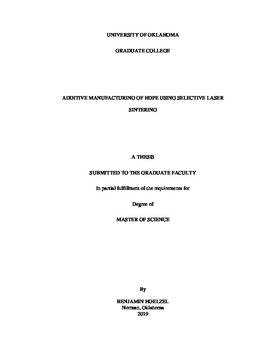| dc.contributor.advisor | Liu, Yingtao | |
| dc.contributor.author | Hoelzel, Benjamin | |
| dc.date.accessioned | 2019-05-10T13:36:07Z | |
| dc.date.available | 2019-05-10T13:36:07Z | |
| dc.date.issued | 2019-05-10 | |
| dc.identifier.uri | https://hdl.handle.net/11244/319676 | |
| dc.description.abstract | Selective Laser Sintering (SLS) is an additive manufacturing technique that bonds solid powder particles into complex 3-Dimensional (3D) shapes. These objects are constructed by repeatedly sintering or fusing layers of powder onto a build plate until the completed part is developed. Through the aid of an open source computer software known as Repetier Host, the desired component is sliced into many cross-sectional layers that are pathed out by a laser. Each new layer is created by new powder being deposited onto the previous layers and again a laser tracing out the cross-sectional path defined by Repetier Host. This technique has become more popular of recent as SLS allows for superior mechanical properties of printed components as well as the lack of required support material due to the excess powder around the print. On the other hand, High Density Polyethylene (HDPE) is a type of thermoplastic that has a high strength to density ratio and can be developed into complex components using SLS. As such, this thesis investigates and reports on the production and characterization of HDPE samples using SLS. The SLS machine used in this thesis was modified from an online design to allow both an affordable way to run experiments with HDPE powder and to truly understand the parameters and specifications needed to print HDPE powder into complex geometries. After running various test prints with HDPE, it was concluded that the most influential factors of successfully printing HDPE involve the ambient chamber temperature around the print, the temperature of the build plate, the laser intensity, the laser scanning speed, and the thickness of each layer. These five factors are crucial for keeping the temperature of the entire sample uniform and inside the sintering window, eliminating the natural tendency of HDPE samples to warp and deform during the printing process. Results show that these influences also directly impact the geometry accuracy, density, and mechanical properties of the printed samples. Finally, the characterization results from the printed HDPE samples were compared to characterization results of casted samples at similar densities and geometries. | en_US |
| dc.language | en_US | en_US |
| dc.rights | Attribution 4.0 International | * |
| dc.rights.uri | https://creativecommons.org/licenses/by/4.0/ | * |
| dc.subject | High Density Polythene | en_US |
| dc.subject | Selective Laser Sintering | en_US |
| dc.subject | Additive Manufacturing | en_US |
| dc.title | Additive Manufacturing of HDPE Using Selective Laser Sintering | en_US |
| dc.contributor.committeeMember | Saha, Mrinal | |
| dc.contributor.committeeMember | Garg, Jivtesh | |
| dc.date.manuscript | 2019-05-08 | |
| dc.thesis.degree | Master of Science | en_US |
| ou.group | Gallogly College of Engineering::School of Aerospace and Mechanical Engineering | en_US |

